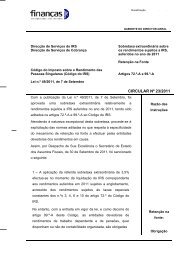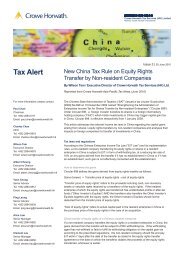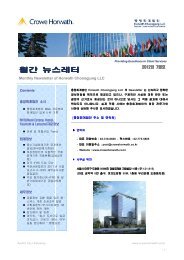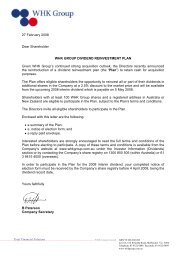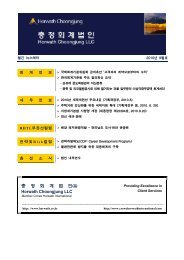Guidance Paper - The Institute of Risk Management
Guidance Paper - The Institute of Risk Management
Guidance Paper - The Institute of Risk Management
You also want an ePaper? Increase the reach of your titles
YUMPU automatically turns print PDFs into web optimized ePapers that Google loves.
Tactical<br />
308<br />
Many organisations struggle<br />
to implement their strategy,<br />
regardless <strong>of</strong> how finely<br />
developed and well-honed it is. <strong>The</strong>re is a<br />
well-recognised phenomenon <strong>of</strong> a gap<br />
between definition and implementation<br />
<strong>of</strong> the strategy. We are describing this as<br />
the tactical element <strong>of</strong> risk appetite: the<br />
cusp between strategic vision and<br />
implementation. This may well be where<br />
existing control mechanisms need to be<br />
reviewed and refined in order to enable<br />
the new strategy to be implemented<br />
effectively.<br />
Our framework suggests that<br />
309 this is where there needs to be<br />
a balance between risk taking<br />
and exercising control. A<br />
well-articulated risk appetite will assist in<br />
defining the relative proportions <strong>of</strong> time,<br />
effort and resources that might need to be<br />
spent respectively on taking the risk and<br />
exercising control. By way <strong>of</strong> example, the<br />
company that decides that it has a large<br />
appetite for a given type <strong>of</strong> risk will<br />
determine at this level how to refine the<br />
way in which control mechanisms operate.<br />
A high appetite for, say, IT risk, which<br />
strategically results in major new systems<br />
developments will not mean that all<br />
control mechanisms should be thrown out.<br />
However, the level <strong>of</strong> detailed<br />
implementation <strong>of</strong> the controls, the levels<br />
<strong>of</strong> review and hierarchies <strong>of</strong> delegated<br />
authorities may well be more relaxed than<br />
in an organisation that continues to have<br />
a sceptical or hostile appetite for IT risk.<br />
Project or operational<br />
310<br />
At a detailed level <strong>of</strong><br />
delivering products or services,<br />
following processes or running<br />
projects, it is likely that the emphasis will<br />
be on minimising adverse risk by<br />
exercising appropriate controls.<br />
Most time, effort and<br />
311 resources will be deployed to<br />
minimise risk, rather than on<br />
taking new risks. However,<br />
even at this level it is important for<br />
individuals to understand how they are<br />
able to respond to new and emerging risks<br />
that they encounter and to have a risk<br />
appetite framework to help them to come<br />
to an appropriate decision. As one<br />
organisation describes it, they want front<br />
line supervisors to be able to respond to a<br />
new or emerging risk as though a member<br />
<strong>of</strong> the executive management team were<br />
standing at their shoulder. By defining risk<br />
appetite, staff will understand how they<br />
should react, and when they should<br />
escalate an issue for consideration further<br />
up the line.<br />
Operational Examples<br />
Different sales departments could<br />
have a different focus depending on<br />
how their specific unit relates to the<br />
defined strategy. Specific sales units<br />
might be directed to take increased<br />
risk to exploit the market in order<br />
to support a new product initiative.<br />
Sales units might have defined<br />
margin requirements<br />
<strong>The</strong> IT department might need to<br />
focus on cost savings and increased<br />
efficiencies to support a strategic<br />
product launch.<br />
<strong>The</strong> legal or policy department<br />
might need to focus on controls to<br />
reduce the number <strong>of</strong> errors.<br />
<strong>The</strong> finance team might be required<br />
to manage the debtor balances and<br />
to ensure sufficient unencumbered<br />
funds in the event <strong>of</strong> a worst case<br />
scenario.<br />
Propensity to<br />
take risk<br />
312<br />
At its most basic, the<br />
propensity to take risk is little<br />
more than understanding<br />
whether a risk or type <strong>of</strong> risk is one that<br />
the organisation wishes to engage with or<br />
not. Some organisations express this in<br />
simple terms such as:<br />
• Avoid (terminate risk)<br />
• Averse<br />
• Conservative<br />
• Receptive (take risk if expected reward<br />
warrants, within limits), or<br />
• Unlimited (take risk if expected reward<br />
warrants, unconstrained by limits).<br />
Others use words like “risk<br />
313 hungry” or “risk cautious”.<br />
However, some would argue<br />
that the propensity to take a<br />
risk is dependent on the reason for<br />
engaging with that particular risk or<br />
group <strong>of</strong> risks.<br />
<strong>Risk</strong> appetite cannot be<br />
314 defined in totality for an<br />
organisation using a single<br />
one word label. <strong>Risk</strong>-averse<br />
companies have little or no future, while<br />
risk-reckless organisations can expect a<br />
rapid exit from business. This is not to<br />
deny that in practice, at the simplest level,<br />
the propensity to take any given risk can<br />
be defined by single word labels.<br />
Although this then needs to be weighed<br />
against the way in which control is<br />
exercised in the relevant area. At its most<br />
sophisticated it will take into account the<br />
reasons that organisations engage with<br />
any given risk and the nature <strong>of</strong> the risk<br />
itself.<br />
Propensity to<br />
exercise control<br />
315<br />
Having defined an<br />
organisation’s propensity to<br />
take risk, it is then important<br />
to establish its propensity to exercise<br />
control. It is our view that setting a risk<br />
appetite without identifying the level <strong>of</strong><br />
control is self-defeating:<br />
• Traditionally risk “averse”<br />
organisations that decide they are<br />
“hungry” for a particular type <strong>of</strong> risk<br />
and that forget the need for retaining<br />
appropriate levels <strong>of</strong> control are likely<br />
to fail, sometimes dramatically;<br />
• Traditionally “innovative”<br />
organisations that decide that they<br />
are “averse” to a particular type <strong>of</strong><br />
risk and that forget to exercise or<br />
increase levels <strong>of</strong> control, are equally<br />
likely to fail.<br />
25






